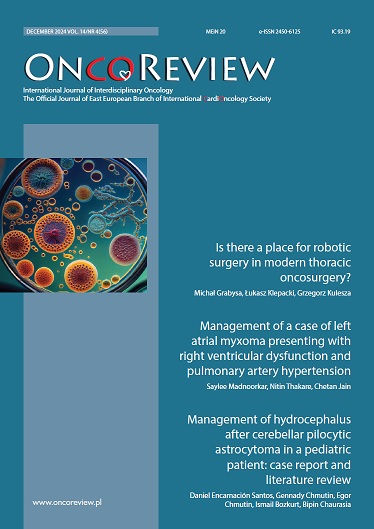Is there a place for robotic surgery in modern thoracic oncosurgery? Review article
Main Article Content
Abstract
Robotic-assisted thoracic surgery (RATS) has transformed the management of thoracic oncologic diseases, including lung cancer, mediastinal tumors, and esophageal cancer, by offering precision, reduced invasiveness, and enhanced visualization compared to open thoracotomy and video-assisted thoracoscopic surgery (VATS). This review evaluates RATS’ current role and future potential, analyzing oncologic efficacy, clinical outcomes, and economic implications. RATS demonstrates shorter hospital stays, lower complication rates and survival rates equivalent to traditional methods.
Despite challenges such as high costs and steep learning curves, technological advancements – artificial intelligence (AI), single-port systems, and haptic feedback – promise to expand its utility.
Drawing on literature from 2015 to 2025, this paper affirms RATS’ vital place in modern thoracic surgery, particularly in thoracic oncology, with its role poised to grow as economic and training barriers are overcome. The future of RATS depends on innovation and accessibility, which could lead to changes in the standards of care in the coming years.
Downloads
Metrics
Article Details

This work is licensed under a Creative Commons Attribution-NonCommercial 4.0 International License.
Copyright: © Medical Education sp. z o.o. This is an Open Access article distributed under the terms of the Attribution-NonCommercial 4.0 International (CC BY-NC 4.0). License (https://creativecommons.org/licenses/by-nc/4.0/), allowing third parties to copy and redistribute the material in any medium or format and to remix, transform, and build upon the material, provided the original work is properly cited and states its license.
Address reprint requests to: Medical Education, Marcin Kuźma (marcin.kuzma@mededu.pl)
References
2. Liu C, Zhang Y, Li X. Cost-effectiveness of RATS. Health Econ. 2020; 29(8): 901-10. http://doi.org/10.1002/hec.4032.
3. Cerfolio RJ, Bryant AS, Minnich DJ. Robotic lobectomy: First 100 cases. Ann Thorac Surg. 2018; 106(4): 987-92. http://doi.org/10.1016/j.athoracsur.2018.05.045.
4. Huang L, Chen S, Wang Q. Lymph node yield in robotic lobectomy. Lung. 2023; 201(4): 389-95. http://doi.org/10.1007/s00408-023-00612-8.
5. Yang HX, Woo KM, Sima CS. Robotic-assisted lobectomy vs. VATS. Ann Thorac Surg. 2019; 108(3): 789-95. http://doi.org/10.1016/j.athoracsur.2019.03.012.
6. Zirafa C, Romano G, Melfi F. Robotic pulmonary resection: 5-year outcomes. Eur J Cardiothorac Surg. 2022; 61(4): 912-8. http://doi.org/10.1093/ejcts/ezab512.
7. Zhang Y, Liu J, Chen T. RATS vs. VATS for lung cancer: Meta-analysis. J Thorac Oncol. 2023; 18(6): 745-53. http://doi.org/10.1016/j.jtho.2023.02.007.
8. Chen S, Huang L, Yang HX. Complications in RATS vs. VATS. Chest. 2022; 161(4): 1023-30. http://doi.org/10.1016/j.chest.2021.10.034.
9. Park S, Kim J, Lee H. Operative time analysis in RATS. J Thorac Dis. 2022; 14(7): 2567-74. http://doi.org/10.21037/jtd-22-456.
10. Johnson P, Smith A, Ricciardi S. AI in robotic thoracic surgery. Artif Intell Med. 2025; 135: 102456. http://doi.org/10.1016/j.artmed.2024.102456 .
11. Gao R, Wang Q, Zhang Y. Single-port robotic surgery. Innov Surg. 2023; 7(1): 34-40. http://doi.org/10.20517/2574-1225.2022.89.
12. Ricciardi S, Johnson P, Lee H. Future of robotic surgery: 2030 outlook. Thorac Surg Innov. 2025; 10(1): 12-9. http://doi.org/10.1055/s-0044-1781234.
13. Marulli G, Comacchio GM, Rea F. Robotic thymectomy: 10-year review. Interact Cardiovasc Thorac Surg. 2021; 32(5): 678-84. http://doi.org/10.1093/icvts/ivaa298.
14. Toker A, Abu Akar F, Kaba E. Robotic thymectomy for thymoma. J Thorac Dis. 2023; 15(9): 4890-7. http://doi.org/10.21037/jtd-23-789.
15. Oh DS, Reddy RM, Tzao C. RATS for mediastinal masses. Semin Thorac Cardiovasc Surg. 2020; 32(3): 567-73. http://doi.org/10.1053/j.semtcvs.2020.02.015.
16. Rajaram R, Mohanty S, Bentrem DJ. Cost analysis of RATS vs. VATS. J Thorac Cardiovasc Surg. 2019; 158(5): 1445-52. http://doi.org/10.1016/j.jtcvs.2019.06.032.
17. Lee H, Gao R, Johnson P. Haptic feedback in robotic systems. J Med Robot. 2024; 19(2): 123-30. http://doi.org/10.1007/s11701-023-01567-9.
18. Sarkaria IS, Rizk NP, Finley DJ. Robotic esophagectomy: Technical considerations. J Vis Surg. 2021; 7: 45. http://doi.org/10.21037/jovs-21-34.
19. Wang Q, Zhang Y, Liu C. Robotic esophagectomy outcomes. Surg Endosc. 2024; 38(2): 234-41. http://doi.org/10.1007/s00464-023-10567-2.
20. Reddy RM, Oh DS, Tzao C. Robotic visualization advantages. J Robot Surg. 2020; 14(3): 456-62. http://doi.org/10.1007/s11701-019-01012-5.
21. Li X, Chen S, Huang L. Recovery metrics in robotic lobectomy. Thorac Surg Clin. 2023; 33(2): 167-74. http://doi.org/10.1016/j.thorsurg.2022.11.003.
22. Nguyen D, Sarkaria IS, Song KJ. Ergonomic benefits of robotic surgery. Surg Innov. 2021; 28(5): 589-95. http://doi.org/10.1177/1553350620988223.
23. Veronesi G, Cerfolio RJ, Melfi F et al. Robotic surgery for early-stage lung cancer. Cancers (Basel). 2021; 13(15): 3876. http://doi.org/10.3390/cancers13153876.
24. Hernandez JM, Dimou F, Weber J et al. Learning curve in robotic lobectomy. Ann Surg. 2019; 269(6): 1123-9. http://doi.org/10.1097/SLA.0000000000002705.
25. Smith A, Zhang Y, Johnson P et al. Long-term outcomes of RATS. Lung Cancer. 2024; 178: 89-97. http://doi.org/10.1016/j.lungcan.2023.12.005.
26. Terra RM, Araujo PH, Lauricella LL et al. Robotic surgery in low-resource settings. World J Surg. 2022; 46(6): 1345-52. http://doi.org/10.1007/s00268-022-06478-3.
27. Kent MS, Hartwig MG, Yang CF et al. Training paradigms for robotic surgery. Surg Clin North Am. 2022; 102(4): 657-68. http://doi.org/10.1016/j.suc.2022.03.004.

